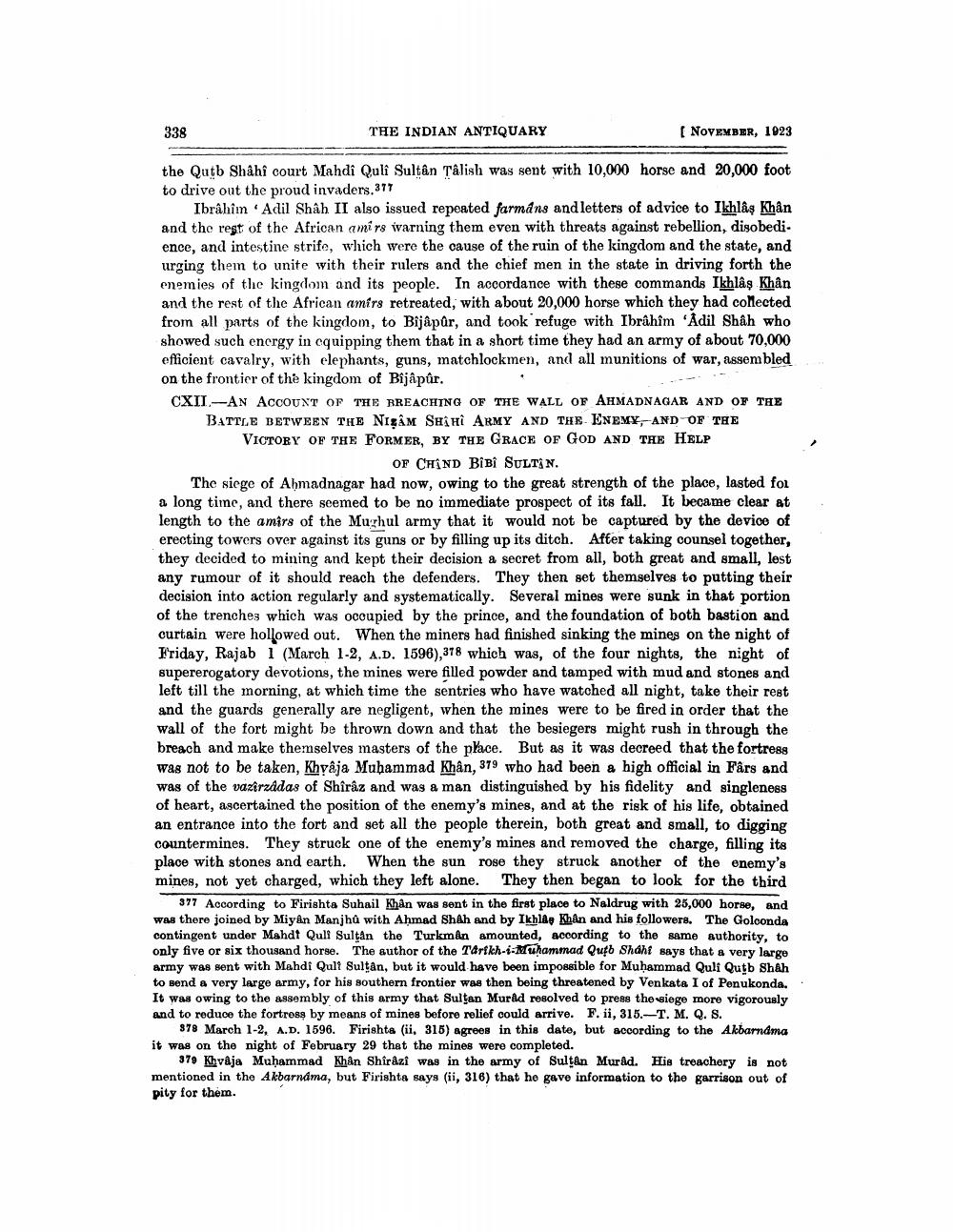________________
338
THE INDIAN ANTIQUARY
( NOVEMBER, 1023
the Qutb Shahi court Mahdi Quli Sultân Tâlish was sent with 10,000 horse and 20,000 foot to drive out the proud invaders.377
Ibrahim Adil Shah II also issued repeated farmáns and letters of advice to Ikhlas khân and the rest of the African amirs warning them even with threats against rebellion, disobedi. ence, and intestine strife, which were the cause of the ruin of the kingdom and the state, and urging them to unite with their rulers and the chief men in the state in driving forth the enemies of the kingdom and its people. In accordance with these commands Ikhlâs Khân and the rest of the African amirs retreated, with about 20,000 horse which they had collected from all parts of the kingdom, to Bijâpür, and took refuge with Ibrahim Adil Shah who showed such energy in equipping them that in a short time they had an army of about 70,000 efficient cavalry, with elephants, guns, matchlockmen, and all munitions of war, assembled on the frontier of the kingdom of Bijapûr. CXII-AN ACCOUNT OF THE BREACHING OF THE WALL OF AHMADNAGAR AND OF THE BATTLE BETWEEN THE NIGAM SHAH ARMY AND THE ENEMY,AND OF THE VICTORY OF THE FORMER, BY THE GRACE OF GOD AND THE HELP
OF CHÍND BiBi SULTIN. The siege of Ahmadnagar had now, owing to the great strength of the place, lasted for a long time, and there seemed to be no immediate prospect of its fall. It became clear at length to the amirs of the Mughul army that it would not be captured by the device of erecting towers over against its guns or by filling up its ditch. After taking counsel together, they decided to mining and kept their decision a secret from all, both great and small, lest any rumour of it should reach the defenders. They then get themselves to putting their decision into action regularly and systematically. Several mines were sunk in that portion of the trenches which was ocoupied by the prince, and the foundation of both bastion and curtain were hollowed out. When the miners had finished sinking the mines on the night of Friday, Rajab 1 (March 1-2, A.D. 1596), 378 which was, of the four nights, the night of supererogatory devotions, the mines were filled powder and tamped with mud and stones and left till the morning, at which time the sentries who have watched all night, take their rest and the guards generally are negligent, when the mines were to be fired in order that the wall of the fort might be thrown down and that the besiegers might rush in through the breach and make themselves masters of the place. But as it was decreed that the fortress was not to be taken, Khyaja Muhammad Khân, 379 who had been a high official in Fârs and was of the vazirzadas of Shîrâz and was a man distinguished by his fidelity and singleness of heart, ascertained the position of the enemy's mines, and at the risk of his life, obtained an entrance into the fort and set all the people therein, both great and small, to digging countermines. They struck one of the enemy's mines and removed the charge, filling its place with stones and earth. When the sun rose they struck another of the enemy's mines, not yet charged, which they left alone. They then began to look for the third
377 According to Firishta Suhail Khan was sent in the first place to Naldrug with 25,000 horse, and was there joined by Miyan Manjhů with Ahmad Shah and by Ikhlae Khan and his followers. The Golconda contingent under Mahdt Quli Sultan the Turkman amounted, according to the same authority, to only five or six thousand horse. The author of the Tarikh-i-Muhammad Qutb Shahi says that a very large army was sent with Mahdi Qul! Sultan, but it would have been impossible for Muhammad Quli Qutb Shah to send a very large army, for his southern frontier was then being threatened by Venkata I of Penukonda. It was owing to the assembly of this army that Sultan Murad resolved to press the siege more vigorously and to reduce the fortress by means of mines before relief could arrive. F. ii, 315.-T. M. Q. S.
878 March 1-2, A.D. 1596. Firishta (ii, 315) agrees in this date, but according to the Akbarndma it was on the night of February 29 that the mines were completed.
379 Khvâja Muhammad Khan Shîråzi was in the army of Sultan Murad. His treachery is not mentioned in the Akbarndma, but Firishta says (ii, 316) that he gave information to the garrison out of pity for them.




